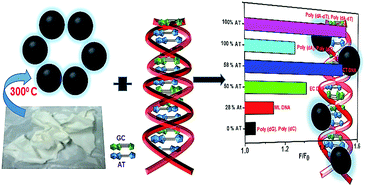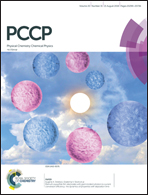Egg-shell derived carbon dots for base pair selective DNA binding and recognition†
Abstract
The development of base pair selective fluorescent binding probes and their interaction mode with nucleic acids have created great interest for sensing and biomedical applications. Herein, we have used chicken egg shell membrane (ESM) as a cost effective easily available protein source for the synthesis of highly fluorescent carbon dots. The detailed characterizations have confirmed the in situ formation of heteroatom doped graphitic carbon nanodots (CDs) from ESM. The intrinsic fluorescence property of the material has been utilized for the label free binding of duplex deoxyribonucleic acid (DNA). The interaction of different natural and synthetic DNAs with carbon dots resulted in the enhancement of fluorescence characteristics of the latter. Analysis of the binding data obtained from steady state fluorescence studies revealed a selective and stronger affinity of CDs to the adenine–thymine (AT) base pair rich double stranded DNA (ds DNA) than that of the guanine–cytosine (GC) pair rich ds DNA. Base pair specific binding was further validated from isothermal titration calorimetry (ITC) and melting temperature data. The thermodynamic profile revealed endothermic binding that was driven by the hydrophobic interaction at the nano–bio interfaces. The results reveal the potential of carbon dots as a new and promising fluorescent probe for base pair selective and sequence specific DNA recognition.



 Please wait while we load your content...
Please wait while we load your content...